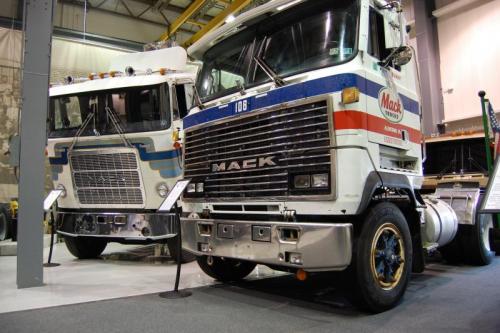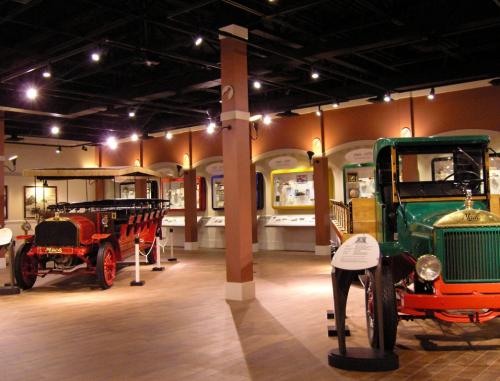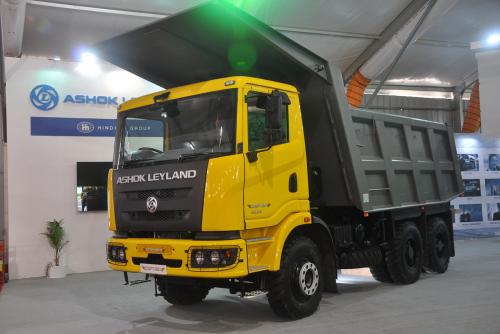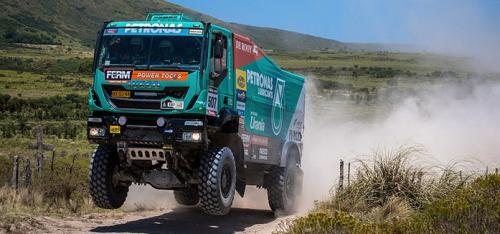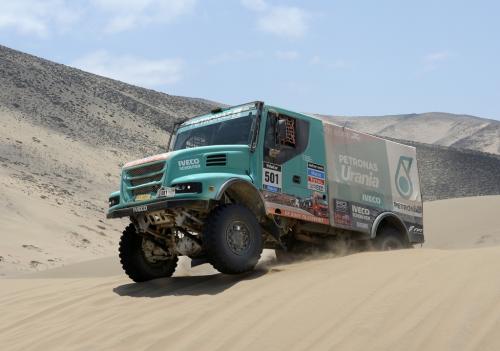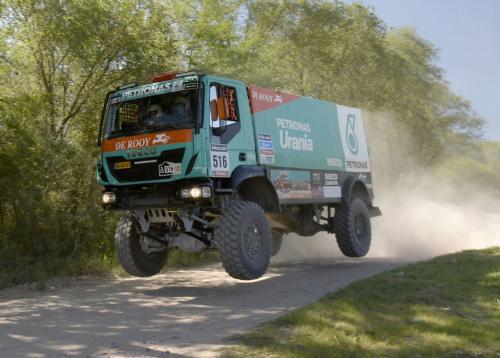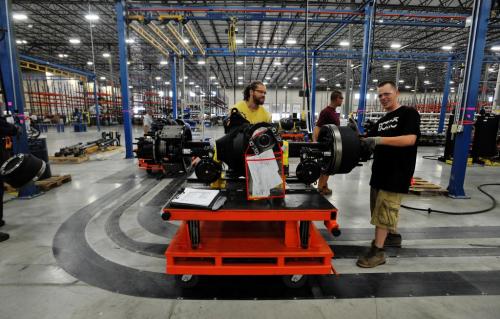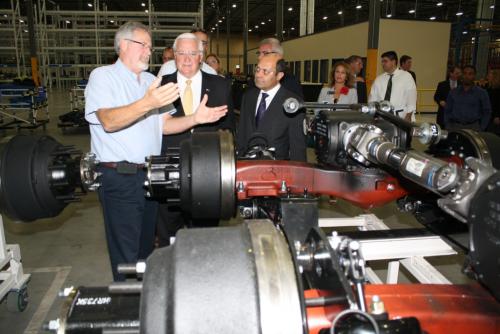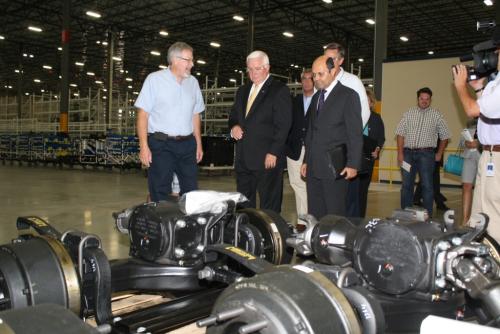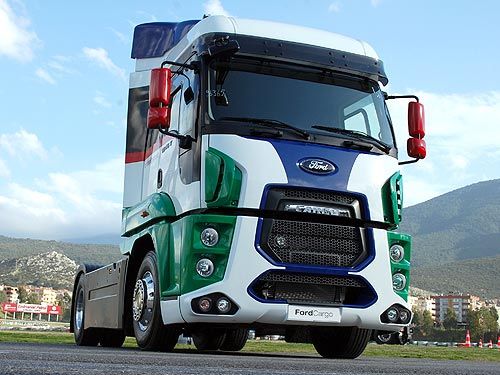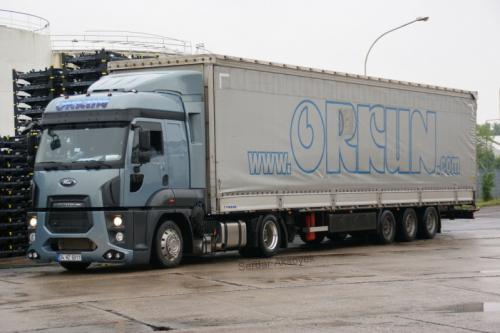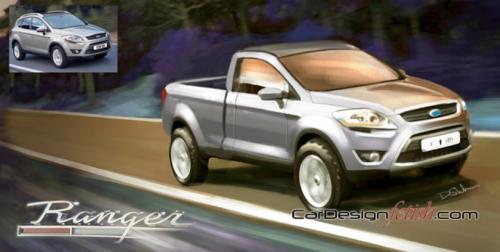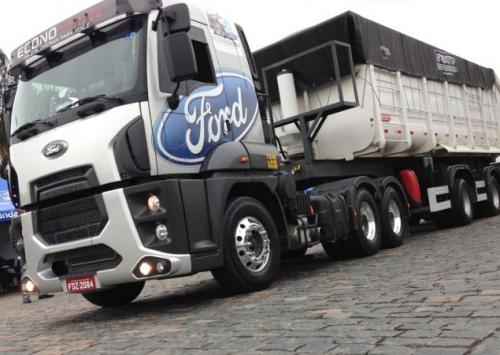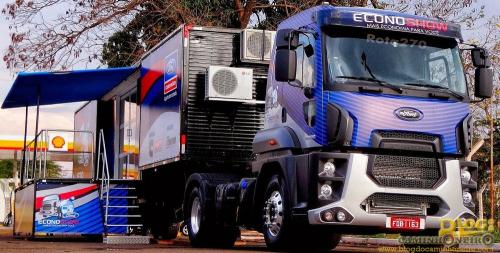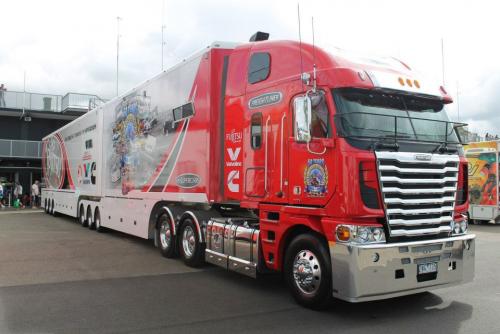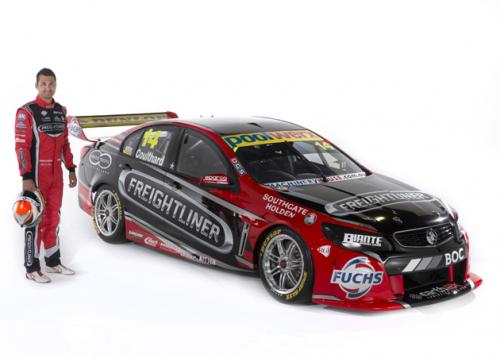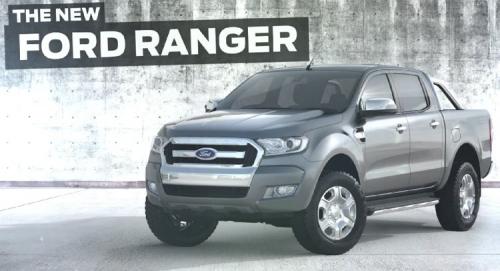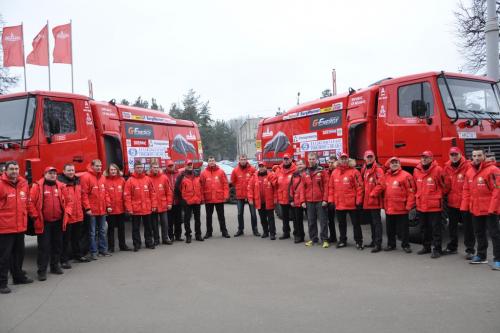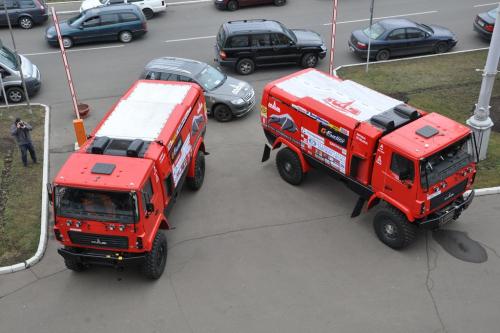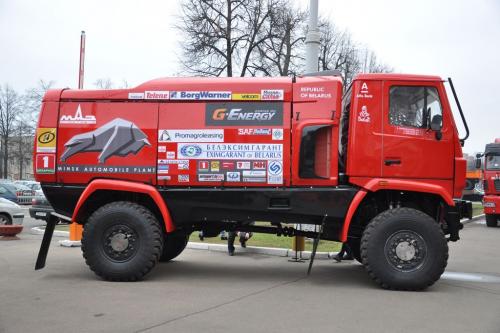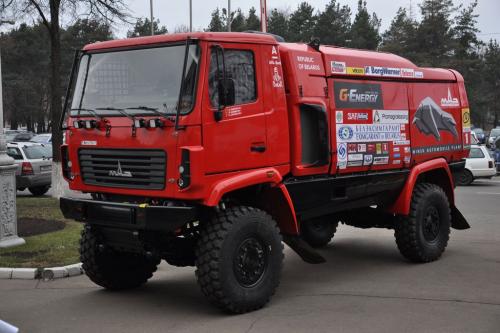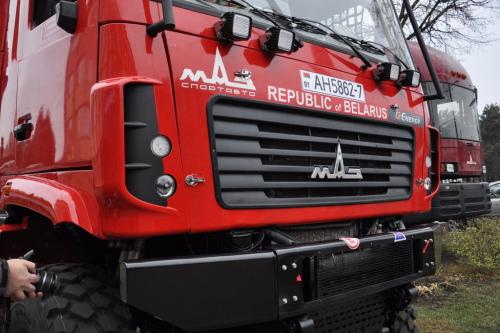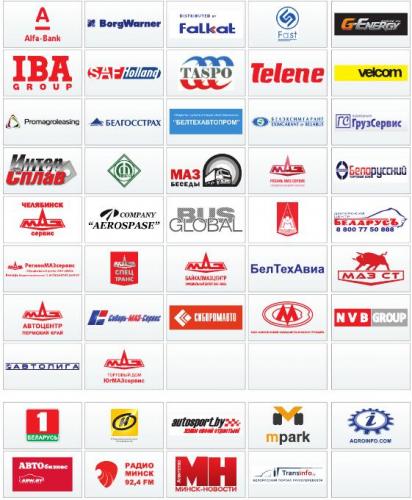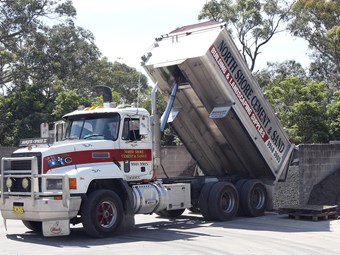
kscarbel2
Moderator-
Posts
18,538 -
Joined
-
Days Won
112
Content Type
Profiles
Forums
Gallery
Events
Blogs
BMT Wiki
Collections
Store
Everything posted by kscarbel2
-
Fleet Owner / December 3, 2014 The Mack Trucks Historical Museum up in Allentown, PA, celebrated its 30th anniversary last month – a non-profit entity formed back in 1984 – and for truck junkies like me, the place offers an endless supply of classic iron and related components to investigate. [It’s also most helpful that admission to the museum is free, with the facility open Monday, Wednesday and Friday from 10 a.m. to 4 p.m.] I’ve visited Mack’s museum a few times (and you can sift through some photo galleries resulting from those stopovers here and here) as it is connected to the Mack Customer Center, which used to serve as the OEM’s research and development facility. The performance roadways surrounding the museum and customer center are still put to good use, too; a prime location for customers and journalists to test drive Mack’s products, as you can see here. The OEM noted that nearly 6,000 people from all parts of the world visit its museum each year, with Mack enthusiasts from Australia and the Netherlands the most frequent foreign visitors. “We also receive thousands of requests about specific vehicles,” added Don Schumaker, the museum’s curator. “If you have a vehicle identification number, chances are pretty good that we have information in our archives.” [Schumaker has by far forgotten more about trucks than most people know. You can view his encyclopedic truck brain in action in the video interview below, shot back in April this year.] The museum also helps host “Trucktoberfest,” an annual “appreciation event” for the antique truck club organizations that support the museum, with more than 300 people and 100 vintage trucks taking part in the festivities. [Below is a glimpse of the “parade of power” taken during this year’s celebration, with a collection of trucks circling the former test track surrounding the museum and customer center buildings.] Perhaps not surprisingly, Mack also helps support another museum, one devoted more broadly to the history of transportation – called “American on Wheels” – that is located in downtown Allentown. Needless to say, if you’re a gearhead that loves old trucks and motor vehicles, both of those placed need to get put on your travel itinerary. .
-
- 5
-

-
Economic Times / December 1, 2014 Indian truckmaker Ashok Leyland today reported a 44 percent jump in total sales at 7,732 units for November, 2014, as against 5,375 units in the same month last year. Sales for its medium and heavy commercial trucks increased by 92 percent at 5,204 units in November as against 2,715 units in the year-ago period. .
-
Press Release / December 2, 2014 Iveco and FPT Industrial to feature at Dakar 2015 Team PETRONAS De Rooy Iveco announces participation in the next edition of the world’s most famous off-road rally. Three Iveco vehicles are set to compete for a place on the podium. Together again, ready to fight for a place on the podium at the 2015 Dakar: Iveco and FPT Industrial (Fiat Powertrain Technologies) will once again feature at the world’s biggest rally – the Dakar – as official sponsors of Team PETRONAS De Rooy Iveco. The news was announced today at a press conference held at CNH Industrial Village in Turin, Italy. In line with their adventurous identities, the two CNH Industrial subsidiaries will provide vehicles, parts and engines for the Netherlands-based Team PETRONAS De Rooy Iveco at the 2015 Dakar rally. The 37th edition of the Dakar – the seventh to take place on South American soil – will start in Buenos Aires, Argentina on 4 January and will finish in the same city on 17 January, after 13 stages following a ring-shaped route. The 414 vehicles on the starting line will have to cover more than 9,000 km (5,592 miles) of roads, tracks and dunes, through Argentina, Chile and Bolivia. Team PETRONAS De Rooy Iveco After taking second place in the 2014 edition of the rally, the Netherlands’ Gerard De Rooy – on board a sleeper-cab version of the Iveco Powerstar – will once again lead the Team. At 34 years old and having won the Dakar in 2012, the Dutchman returns to the race with more determination and enthusiasm than ever, ready to face the extreme challenges that the rally presents each year. Behind the wheel of a second Powerstar will be fellow Dutchman Hans Stacey, winner of the Lisbon-Dakar in 2007 and a member of Team PETRONAS De Rooy Iveco since 2011. The third vehicle, a day-cab Trakker Evolution 3, will be under the control of Spanish driver Pep Vila, a rally veteran and a Team fixture at the Dakar. Iveco's race vehicles: strength, reliability and performance even over the toughest terrain The Dutch team will use three Iveco vehicles at the 2015 Dakar: two Powerstars (specifically, a Strator prototype – built in the Netherlands with an Iveco chassis, driveline and cab inspired by the Powerstar, manufactured and marketed by Iveco Australia) and a Trakker 4x4, manufactured in Spain. In addition to the rally trucks, six support and assistance Trakkers will complete the Team PETRONAS De Rooy Iveco line-up: one 8x8s, four 6x6s and one 4x4. The Iveco Trakker is an off-road quarry-site vehicle, with a new cab designed to improve driving and on-board comfort, elements which today are recognized as essential for the productivity and safety of a vehicle. This vehicle is capable of operating on difficult, bumpy terrain, like the surfaces the drivers will need to navigate on in South America, and relies on FPT Industrial's Cursor engines, which ensure power and reliability. The defining characteristic of the vehicle is its sturdiness: each individual component, starting from the high-yield steel chassis, guarantees long lasting performance. The Trakker represents a “Best in Class” not only for its day-to-day use, but also in more challenging environments, having been designed to work in all weather conditions and on all types of terrain, from dirt roads to extreme off-road trails, ensuring maximum comfort, safety and output. The vehicles are fitted with three rally seats with seat belts and a roll-over protection bar. The vehicles feature ZF gearboxes providing both ergonomics and performance. These include the Ecosplit 9- and 16-speed manual gearboxes, both equipped with a "servo-shift" servo-assist system which offers a more comfortable and safer driving experience, and the Eurotronic 12- and 16-speed automatic gearboxes, with gear selector built into the steering column switch, which helps to improve driver comfort. The Dakar will represent an important occasion for Iveco to test the performance of the products in action: each vehicle will face huge challenges in extreme conditions, thus providing an opportunity to test the vehicles’ reliability and performance. The engines All Iveco vehicles participating in the 2015 Dakar are equipped with FPT Industrial Cursor 13 engines which generate up to 900 horsepower. Thanks to continuous research and development activities, the in-line six-cylinder Cursor 13 adopts the most advanced technologies available, such as latest generation Common Rail HD injection system, guaranteeing pressures up to 2,200 bar. These engines provide high power, fast load response and high power density and ensure maximum robustness and reliability, and low operating costs. To ensure such a high level of reliability, FPT Industrial puts its powertrains through several thousand hours of rigorous testing and, above all, tests them in extremely challenging sporting competitions such as the Dakar. The 2015 Dakar The race will take place in three major South American countries from 4 to 17 January: Argentina, Chile and Bolivia. The route forms a ring, starting in Buenos Aires in Argentina, reaching Iquique in Chile, and returning once again to the Argentinian capital. Argentina will therefore host both the start and end of the race, as well as a further six stages. The rest of the race will take place in Chile, plus one stage in Bolivia, as the 9,000 km route weaves its way through a landscape of desert and rocks. Like last year, there will be different routes for cars, trucks, bikes and quads. In particular, the truck route will be nearly 1,000 km shorter to avoid having heavy vehicles passing through Bolivia's salt flats. This decision also stemmed from a desire to respect and protect the environment hosting this spectacular and strenuous race. A total of 414 vehicles have registered for the race this year: 164 bikes, 138 cars, 48 quads and 64 trucks, with 665 competitors representing 53 different countries. Follow all the news at www.iveco.com/dakar Iveco is getting ready to keep its fans up to date throughout the rally on www.iveco.com/dakar. Fans can learn all about the PETRONAS De Rooy Iveco vehicles in the run-up to the start date, and then follow the race step by step with daily updates from South America. The website narrates a journey through the world’s most difficult and demanding off-road race. The website will be updated every day with Team PETRONAS De Rooy Iveco’s results and performance data, plus multimedia content transmitted directly from the course itself. Likewise, the Team's social media channels – Facebook, Twitter and YouTube – will be updated every day, with all the latest news as well as reports, videos and photos. There is also an area dedicated to Iveco’s Dakar Rally history: a look back at the team’s successes on the unforgiving roads of a competition that attracts millions of spectators every year. Finally, the section “From Dakar to your job” offers Iveco customers the chance to discover all the features of the Trakker, known for its reliability in day-to-day work on quarry sites and also in extreme situations such as the Dakar: this confirms that this type of event is an excellent opportunity to test the performance and reliability of the whole vehicle under extremely challenging conditions. Iveco and its commitment to sports The Dakar is part of Iveco's wider communication strategy, which – given its strong international identity and the ongoing pursuit of initiatives matching its vitality and energy – has always kept close ties with the world of sport. Iveco's involvement in the Dakar reinforces the brand's strong affiliation with the leading names in international sport. Past collaborations span a wide range of sporting initiatives including a partnership with Rugby World Cup champions the All Blacks from Australia and Iveco’s role as Official Supplier to Ferrari's racing team. DAKAR 2015 - THE TEAM Vehicle 501 Gerard De Rooy Driver (Netherlands) Jurgen Damen Navigator (Belgium) Darek Rodewald Mechanic (Netherlands) Vehicle 504 Hans Stacey Driver (Netherlands) Serge Bruynkens Navigator (Belgium) Bernard der Kinderen Mechanic (Netherlands) Vehicle 509 Pep Vila Driver (Spain) Xavi Colome Roqueta Navigator (Spain) Michel Huisman Mechanic (Netherlands) - See more at: http://www.iveco.com/en-us/press-room/release/Pages/Iveco-Dakar-2015.aspx#sthash.rPROw9rx.dpuf .
-
An example of low-cost manufacturing (one level above doing it in your garage). Volvo's Mack brand retail truck pricing doesn't pass along the discount though. Note: Westport Axle is owned by Brazil Group (Grupo Brasil). .
-
Heavy Duty Trucking / December 2, 2014 A plan in Michigan’s Senate to greatly reduce the maximum truck weight along state roadways was defeated Tuesday in a 22-15 vote. The measure called for reducing the gross truck weight limit from 164,000 pounds (74.4 metric tons) along some routes to the current limit along federal routes of 80,000 (36.3 metric tons). Supporters of the legislation claimed the extra heavy trucks were unnecessarily damaging Michigan roadways. Opponents, including the Michigan Department of Transportation, said any damage was mitigated by having loads evenly distributed over multiple axles. According to Mlive.com a truck weighing 164,000 pounds can freely operate in Michigan only if it features 11 separate axles, each carrying 13,000 pounds (5.9 metric tons). Under federal rules, trucks that weigh 80,000 pounds can carry 17,000 pounds (7.7 metric tons) each on four axles and 12,000 pounds (5.4 metric tons) on a steering axle. http://www.mlive.com/lansing-news/index.ssf/2014/12/michigan_roads_bill_to_reduce.html
-
Ford Trucks’ Econoshow Caravan Touring Brazil
kscarbel2 replied to kscarbel2's topic in Trucking News
It's refreshing to see Ford aggressively promoting heavy trucks in the global market, particularly with Bill Ford's personal support. Thus far, I think they've done a great job with the new Cargo. That being said, Ford has a great opportunity now to put a full-size cab on a next generation Cargo and create a heavy truck that can take on M-B, MAN, Scania and Volvo. http://www.fordotosan.com.tr/haberdetay_YeniFordCargo1846T.htm . -
Newsletter - December 2014 http://app.mailerlite.com/p7s0a1/231294478/z8a6/4394617799
-
- 1
-

-
Scania Service Operations Release / November 28, 2014 A new Scania approach to working with brakes has made the job of service technicians easier and lessened the potential for accidents and chronic health problems. An ergonomics training programme for service technicians to reduce risks of strain-related disorders. The training, which is available in 23 languages, combines e-learning with on the job training by supervisors. The e-learning training is available here: http://host.learnways.com/scania/ergonomics/index.htm Working with brakes is one of the most frequently undertaken jobs in Scania workshops. Truck and bus brake components are often heavy and have traditionally been moved manually. Over time, such an approach can lead to back disorders and, in serious cases, chronic illness that requires time off work. To reduce the risk of such problems arising, Scania has developed new methods for working with brakes that both save time and prevent sore backs. One example of the new methods is a mobile hoist that can be used to remove brake components, such as callipers and brake discs. These are operations that previously required a high degree of physical strength. Clear results The new methods have already been put into use in Scania’s operations in Spain and Portugal. Scania Iberica’s Human Resources Manager José Tirado says, “The result is striking, not only with regards to the shortening of lead-times, but because the job can now be performed without risking the health of service technicians. Another benefit of the new methods is that almost anyone can change brakes. It’s traditionally been a very heavy job that not everyone could do.” Ergonomics training Lena Nord Nilsson, a Scania ergonomist who helped develop the approach, says the methods have been included in Scania ergonomics training for service technicians. “The training programme has been made available globally in 23 languages and the programme is one of the most comprehensive health and safety training efforts in the company,” she says. “It is also recommended for distribution to schools for transport and automotive technology.” The programme is divided into two parts – an e-learning course and on-the-job training. The programme material highlights 12 common operations and shows how they can be performed in an ergonomically sound way. Reduced strain For example, strain is placed on the backs of technicians if they remove wheel nuts while in a standing position. Technicians can significantly reduce strain by using a portable seat that allows them to sit down to carry out the nut-removal operation (See picture). Ear protection devices should also be worn to block out the noise of the wheel nut removal tool. Nord Nilsson says the methods in the program involve avoiding working methods that place unnecessary strain on the body.
-
Press Release / November 28, 2014 This video shows how a Scania 12+2-speed range-splitter gearbox is assembled at the Scania gearbox production facilities in Södertälje, Sweden. Gearboxes are also produced in Tucumán, Argentina. All transmissions used in Scania’s long-haulage trucks are developed and manufactured by Scania. Shot in time-lapse, the video shows the whole transmission assembly process, something that takes about an hour in real life. Scania’s modular system allows Scania R-series trucks to be equipped with a range of transmissions, from the 8-speed range-change transmission all the way up to the top-of-the-line 12+2-speed range-splitter transmission. The optional overdrive feature allows for low and economical cruising revs. This is in line with Scania’s low-rev approach, where peak torque is available at low revs, enhancing fuel economy. To further improve driveability, Scania R-series trucks can be equipped with the Scania Opticruise automated gear changing system (AMT), as well as Scania Retarder – an auxiliary braking system first introduced in 1993. The most recent addition to the transmission range is a 4,100 Nm freewheeling retarder that automatically disengages and enters a freewheeling mode when not active, thus reducing fuel consumption. https://www.youtube.com/watch?v=f0mHS71YEUU&feature=youtube_gdata
- 1 reply
-
- 2
-

-
CBC News / November 30, 2014 Paccar's Ste-Thérèse truck manufacturing plant has locked out its 850 employees amid stalled negotiations with the workers’ union. On Saturday afternoon Paccar warned employees it would lock them out at midnight, citing a "no contract, no work" policy. The workers’ collective agreement expired at 11:59 p.m. Saturday. The company tabled its final offer on Saturday afternoon, according to The Canadian Press. The union's negotiating committee called for an assembly on Sunday morning to deliberate on it. However, Paccar did not move the lockout deadline to allow the union to consider the offer. Seventy-six per cent of employees voted on Sunday to reject the offer. According to a news release issued by the union, Unifor-Québec, contract negotiations have been underway for the past two months. In 2001, the then-union president locked himself in an office with 70 litres of water and went on a hunger strike to denounce what he called abusive workplace practices. Paccar, a U.S.-based company, last locked out all of its Ste-Thérèse employees in 2004.
-
If I remember correctly, production shifted from Louisville to Twin Cities (St. Paul, MN) and Edison (NJ) in 1999. Launched in 1993, the second generation Ford Ranger was forced to carry on until its 2011 US market demise with nothing more than trim changes. For the overall US market pickup truck leader to have done what they did to the Ranger marque, intentionally run this product into the ground, is totally unacceptable. I can't believe that Bill Ford* is onboard with Ford corporate's strategy to continue ignoring the mid-sized pickup truck segment (there is no more small pickup segment, we've all seen the light and graduated to mid-sized). He's too realistic a person not to recognize the size and profitability of the segment, and the need for Ford to participate in it. * Bill Ford is arguably one of the finest human beings in America's auto industry.
-
For the record, Ford produced Rangers at Louisville (LAP) from 1983 to April 1, 1999. The absurd statements from Ford that offering the mid-sized Ford Ranger in the US market would erode full-size F-150 sales is pure propaganda. They made a bad call that now leaves them empty-handed in a generously-sized market segment, and don't want to admit it.
-
The Ford Australia-designed global Ford Ranger is produced by Ford in Argentina, South Africa and Thailand, and sold in 180 countries (excluding the U.S. - the world's largest pickup truck market). Ford does sell the Ranger to Mazda, rebadged as the BT-50. The exterior (and interior) is quite different, as it should be, but I don't care for the styling theme. There is a vast swath of consumers who specifically want a mid-sized pickup for all its advantaged. They would never buy a full-size trucks with all its bulk due to personal preference, planned usage and fuel economy. You buy the shoe that fits your foot, and full-size trucks are too large for these customers. For as long as Ford wants to be hard-headed (in the US market), Toyota and GM are glad to have a monopoly on the mid-sized pickup market segment. Ford dare never say they won't sell the Ranger in the US market because as an import, the chicken tax (Lyndon Johnson's Proclaimation 3564) would make it too expensive. Given the US market is the world's largest pickup truck market, of course they would build it in the United States. And that then brings the impressive new body-on-frame Everest SUV into the conversation as it shares the same platform as the new 2015 Ranger. The unibody-construction Explorer is an evolved minivan-turned-SUV for soccer moms, and dad's driving the family around on the weekend, that don't want to be seen in a mini-van. Whereas the body-on-frame Everest is an actual truck that a man would buy for himself. Given the night-and-day difference between the design direction of the Explorer and Everest, and the current gap in Ford's U.S, market portfolio of SUVs - a mid-sized SUV that appeals to men (a modern day Bronco....and they could name it just that) - it makes a perfect sense for Ford to produce the Ranger and Everest (Bronco) in the United States (unless, Ford feels like they have all the business they need).
-
The global Ford Ranger is a direct competitor to Volkswagen's superb mid-sized Amarok pickup in the global market. The new 2015 Ranger appears slightly larger than the Amarok with a more rugged American-style appearance (ironic given that Ford ridiculously doesn't sell it here). Both are available with great diesel powertrains (which attracts me), and in a variety of trim levels from bare bones work truck to high-end personal use. Two or four doors, 2wd or 4wd. You could buy the Ranger or the Amarok and be equally happy. Ford's 3.2-liter diesel (over the more frugal 2.2L engine) at 201hp has a bit more power than the Amarok's 180hp 2.0-liter engine, but the VW is a bi-turbo design and thus quite responsive at both low and high RPMs plus its paired with the superb ZF 8-speed transmission.
-
When I think of Jeep and small pickup trucks, the Jeep Comanche immediately comes to mind. Make no mistake about it, American Motors had some of the US auto industry's finest engineers (delivering impressive designs despite a tight budget), and they were critical to Chrysler's later success (the whole "platform" design theme was invented by AMC engineers). http://upload.wikimedia.org/wikipedia/commons/b/b7/Jeep_Comanche_Pioneer_white_MD_l.jpg Then I leap ahead to 2005 and wonder why the Jeep Gladiator concept didn't enter production. http://blog.jeep.com/wp-content/uploads/2013/01/Jeep-Gladiator-Concept-003.jpg Of course one can have a Wrangler pickup, an impressive unit built by Jeep OEM supplier AEV that retains the factory warranty. http://www.aev-conversions.com/vehicles/brute-double-cab If one were to imagine a modern day Jeep Comanche, it might look something like this. http://i.ytimg.com/vi/jucMyOusy3U/maxresdefault.jpg
-
Ford 's truck marketing manager Dave Scott said last month that the company is considering a return to the U.S. small pickup truck market (which it abandoned in 2011). However, he oddly stated the U.S. market Ranger would NOT be the (superb) global market Ranger (i.e. the logical candidate). Instead, Scott said Ford was reviewing its international models for something it could make work. Scott ridiculously claims the global market Ranger is "Too big, it's 90% of the F-150 size." Ford is unwilling to admit (at this juncture) that mid-size and full-size pickup truck consumers are two entirely different groups of people. And with the higher cost of the new aluminum bodied F-150, the global market Ranger would be meaningfully cheaper in price. Scott says Ford is aiming for a “true small pickup”, not a mid-size like GM’s new 2015 Chevrolet Colorado and GMC Canyon, or Toyota’s Tacoma. In its day, the Mazda-sourced Ford Courier (a true small pickup) fulfilled a small but legitimate market demand. But it was never a big sales success either. Fast forwarding to the present, having learned from past experience, consumers now see the advantages of the slightly larger mid-sized pickup. (If Ford wants to sell a true small pickup, they can go to battle with Mahindra in India) "We're looking at it. We think we could sell a compact truck that's more like the size of the old Ranger, that gets 6 to 8 more miles per gallon than our full-size F-150, is $5,000 or $6,000 less, and that we could build in the U.S. to avoid the 25% tariff (chicken tax) on imported trucks," he said. (The truck should/would be made in the U.S., so the 25% chicken tax (import tariff) isn’t a factor) Scott said there are models in Ford's global array of trucks that could work - but he wouldn't name them. Nor would he say how fast Ford could get such a vehicle into showrooms. He said it's likely such a model would have unibody construction – not the traditional body-on-frame configuration that all U.S. market pickups use aside from the Honda Ridgeline (which is barely on anyone’s radar). (Imagine a Ford Escape/Kuga-based pickup similar to the Dacia Logan pickup...... http://www.daciagroup.com/en/gallery/products/dacia-logan-pick-up) Scott, unwilling to admit Ford’s mistaken strategy in ignoring the mid-sized pickup segment, embarrassed himself by claiming that GM’s new 2015 Chevrolet Colorado and GMC Canyon are too big. As an excuse for not having a mid-sized pickup to offer, Scott said a Ford F-150 XL Sport would give a buyer more room, more power, similar mileage and higher towing and hauling ratings, for payments about $20 a month more than the GM mid-size models that are expected to be the best sellers. Scott in unwilling to admit that most consumers wanting a mid-sized pickup truck are NOT in the market for a full-sized pickup. Anyone that sees the global Ford Ranger will judge it to be a mid-sized pickup. It is incomparable to an F-150. American mid-size pickup customers want body-on-frame construction. Few if any would buy a mid-size pickup based on a unibody-construction passenger car platform (e.g. Honda Ridgeline).
-
Trucks Icarros / November 26, 2014 Ford’s Brazilian commercial truck unit is on the road in Brazil demonstrating the fuel economy benefits of its latest heavy trucks. Ford's Econoshow Caravan includes the Cargo 2042 4x2 heavy tractor, Cargo 2842 6x4 heavy tractor and the Cargo 2429 6x2 heavy rigid (straight truck). Ford is conducting classes on the benefits of the Cargo’s fuel efficient powertrains, as well as providing instructional test drives to help customers maximize their truck’s performance and fuel economy potential by taking advantage of the Cargo’s real-time driver information system This year's Caravan has visited 24 cities so far and reached out to over 6,500 operators. http://fordeconoshow.com.br/category/galerias/ For information on when the caravan will visit your area, visit: www.fordeconoshow.com.br site. .
-
Prime Mover / November 28, 2014 Freightliner Trucks has announced a three-year partnership with V8 Supercar team, Brad Jones Racing, as of the 2015 season. At a special function held at Daimler Truck’s Melbourne headquarters the Freightliner Trucks/Brad Jones Racing Commodore entry was revealed for the first time and in doing so ended weeks of speculation as to which Daimler Truck & Bus brand would adorn the bodywork of car number 14. “There are strong parallels between the V8 Supercar audience and Freightliner Trucks,” said Daniel Whitehead, the Managing Director of Daimler Truck & Bus in Australia. “Freightliner Trucks are as traditional as the much loved Aussie V8 sedan; big and powerful that cover huge distances with ease,” he said. “To be aligned with a team as professional as Brad Jones Racing, which has also surpassed a 25 year milestone in motor racing, couldn’t come at a better time for our brand.” Rodney West, Senior Manager, Freightliner Trucks said the involvement with Brad Jones Racing will greatly reinforce Freightliner Trucks presence in Australia. “To have the opportunity to raise awareness of the Freightliner brand in the market place is crucial in this highly competitive world,” he said. The Freightliner Trucks/Brad Jones racing will make its public debut at the V8 Super Test in Sydney on February 7th/8th and its competition debut at the 2015 Clipsal 500 in Adelaide, February 26-March 1st. The Commodore entry will be driven by renowned and highly respected driver Fabian Coulthard who joined Brad Jones Racing in 2012. http://www.v8supercars.com.au/news/championship/freightliner-backs-coulthard http://www.v8supercars.com.au/news/championship/randd-boost-for-bjr .
-
The exhaust-driven motor generator (turbo generator) is a brilliant and viable concept that has been waiting for technology to catch up with the idea. Now it largely has. Taking advantage of free waste exhaust energy while at the same time eliminating the engine (belt) driven alternator for enhanced fuel economy is intriguing. John Deere was experimenting with the concept nine years ago (Note the John Deere-powered Navistar 8600 on page 23). https://www1.eere.energy.gov/vehiclesandfuels/pdfs/deer_2006/session6/2006_deer_vuk.pdf Honeywell (formerly Garrett AiResearch) worked on the concept in the late 1990s, but I believe their approach (with an electric motor sandwiched between the two turbo housings) was flawed.
-
Press Release / November 25, 2014 Belarus-based truckmaker MAZ (Minsk Automobile Plant) held a press conference on November 17, 2014 devoted to the truckmaker's upcoming participation in the 2015 Dakar Rally. The companies race trucks and support vehicles were present for journalists, just ahead of their shipment to Latin America via the French port of Le Havre. The race team members will leave for Buenos Aires at the end of December. MAZ President Valery Ivankovich, team PR director Dmitry Korotkevich, team chief Valery Kozlowski and race drivers Sergey Vyazovich, Alexander Vasilevsky and Alexander Polishchuk took questions from the media and explained the 2015 race truck's new lightweight designs, as well as their expectations concerning the forthcoming race. The company also expressed its gratitude to its long list of sponsors (shown below). The DAKAR 2015 rally will take start on January 4, 2015 in Argentine capital of Buenos Aires. This time the Belarusian team will be presented by three crews: Crew no. 1: pilot– Alexander Vasilevsky; navigator – Valery Kozlowsky ; mechanic– Anton Zaporoshchenko. Crew no. 2: pilot– Sergey Vyazovich; navigator – Pavel Garanin; mechanic– Andrey Zhigulin Crew no.3: pilot – Alexander Polischchuk; navigator– Dmitry Vihrenko; mechanic – Alexey Neverovich. The MAZ race team will be facing opponents from other major global truckmakers including DAF, GINAF, Hino, Iveco, Кamaz, LIAZ, MAN, Mercedes-Benz, Renault, Scania and Tatra. A major focus of the new truck's engineering was weight reduction, resulting in a 100 kilogram decrease. Changes were made to the driving lamp mounting arrangement, aluminum fuel tank, front spring bracket configuration and front fenders. A lightweight carbon fiber driveshaft was also utilized. As a result of a new mounting configuration for the truck's transfer case, it can now be changed in just a few hours. In addition, all of the truck's special racing shock absorbers are now interchangeable. MAZ Group's powertrain partner, YaMZ (Yaroslavl Motor Plant) has gone to great lengths to fine tune the V-8 engines, which are race-rated at 920 horsepower. The 2015 Dakar rally will be the fourth that MAZ has participated in. “We are confident in ourselves and in our trucks. The experience we gained from past Dakar rallies has allowed us to hone our skills for higher results“, said team leader Valery Kozlowski . Note: http://en.wikipedia.org/wiki/Dakar_Rally For additional information about the MAZ 2015 Dakar race team, e-mail pr@maz.by..
-
- 1
-

-
Heavy Duty Trucking / November 25, 2014 The Department of Transportation will not deliver its comprehensive study of the truck size and weight issue on time. The DOT said it will delay delivery of the study until next year. “We recognize many people, including Congress, are eagerly awaiting the release of the report,” DOT said. “However, the department is committed to producing the most objective, data-driven report possible. Based on the current status and the scope and importance of the task at hand, we have had to delay completion of the study until 2015.” The study was due this fall as part of preparation for the next highway bill. The bill also was originally due this fall, but Congress pushed it back to next May because it could not resolve political differences over how to pay for the federal highway program. The study is intended to give Congress an objective assessment of the controversial issues surrounding truck sizes and weights. Large trucking companies and shippers say the current federal limits are outdated and are preventing productivity increases that could go a long way toward relieving highway congestion and improving safety. Just as assertive on the other side are owner-operators, safety advocates and labor unions that say heavier trucks are an unacceptable safety risk. And the railroads oppose any capacity increase for trucks. The 2012 highway bill ordered DOT to do a comprehensive analysis to provide Congress the background for a decision. The work is being done by the Federal Highway Administration, which is looking at the safety and economic implications of changing the federal limits. The study will compare trucks operating at current size and weight limits to bigger and heavier trucks on the basis of crash rates and other safety risk factors, as well as the costs of effective enforcement, and the impact of the equipment on pavements and bridges. It also will look into the impact on truck-rail competition. In its notice Monday FHWA said that it is accepting comments on the work done so far. More information is available on the agency’s website.
-
Australasian Transport News / November 26, 2014 The scheme governing vehicle safety and design in Australia has been brought into line with international standards, opening the way for the country to adopt the latest technological advances as they become available. The Federal Government today announced changes to the Australian Design Rules (ADRs) to harmonise them with the relevant United Nations (UN) regulations. "The reforms announced today are a step towards ensuring that every time a UN regulation is updated the relevant ADR can be updated automatically, ensuring the latest technology is available in the Australian market as quickly as possible," assistant infrastructure minister Jamie Briggs says. The first two UN regulations to be adopted as part of the change cover front fog lamps and rear vision devices. Briggs says the regulation on fog lamps allows for testing methods that better represent real world conditions for front fog lamps, while the second regulation permits the introduction of new types of rear vision devices and provides for more robust testing methods. "Applying these two regulations alone is expected to deliver nearly $1 million in industry compliance savings every year, as manufacturers will have the option of supplying fully approved UN products as part of their certification of vehicles," Briggs says. "This will ensure manufacturers no longer need to produce older products specifically for Australia, meaning consumers will have access to safer vehicles sooner at the lowest possible cost." Briggs says the Federal Government is currently working with industry and state and territory agencies to determine further UN regulations that can be applied.
-
Australasian Transport News (ATN) / November 25, 2014 Mack crows about 1995 CHR tipper, which receives first look inside engine at 1.6 million kilometres. Mack is trumpeting the virtues of its engines after a small Sydney operator clocked up more than 1.6 million kilometres before needing work done on his trusty steed. Sam Seminara of North Sydney Cement and Sand recently brought his 1995 Mack CHR Elite tipper in for a new head gasket and a first-ever look inside its engine. Mack says technicians at its Sydney West dealership in Blacktown declared the pistons in the 12 litre EA7-427 motor to be as good as new. That’s despite more than 46,000 hours and 1.67 million kilometres (more than 1 million miles) carting and tipping 32-tonne loads of sand, screenings, metal or gravel all over metro Sydney building sites. Seminara asked for an in-chassis "freshen up" while the truck was at the dealership. "I’m a very happy and proud owner of this Mack," Seminara says. "I think Mack offers a very well-engineered package and with regular servicing and a good driver, you get this excellent result. "I reckon it would’ve done 2 million plus kilometres if not for the gasket." Mack says the regular driver of the old truck from new, John Gibbons, is even more enthusiastic. "The CHR Mack’s been a brilliant truck, super reliable, easy to drive with plenty of torque low down, comfortable cab and perfect vision out front and through good modern mirrors," Gibbons says. "Its Mack T318LR 18-speed manual trannie racked up 1.3 million kilometres before overhaul, it has nice low ratio reverse gears which are ideal for the work I do, and its Mack 200 Series diffs are still untouched. "I’m such a Mack fan I restored Sam’s old R600 to show quality a few years ago but that didn’t stop it working." Mack Trucks Australia vice president Dean Bestwick says Seminara’s experience shows Mack gets it right when building trucks for Australian conditions. "We love these stories when our customers demonstrate the reliability and durability of Mack trucks, especially the proprietary driveline such as is in this CHR model," Bestwick says. .
-
The Morning Call / November 25, 2014 Workers at Westport Axle's Lehigh County plant have turned down an effort at unionizing. By a 169-126 vote Friday, assembly employees at the Upper Macungie Township chassis plant rejected a petition by the United Auto Workers Union Local 677 to organize, said Harold Maier, assistant regional director of the National Labor Relations Board in Philadelphia. The company makes chassis for Mack Trucks at a plant near Mack's manufacturing facility in Lower Macungie Township. A company official declined Tuesday to comment on the vote. Officials with Local 677 could not be reached Tuesday and previously had declined to comment on the effort. Local 677 filed a petition with the National Labor Relations Board on Oct. 14 seeking to represent about 300 Westport workers, said Harold Maier, NLRB assistant regional director in Philadelphia. The petition excluded other employees, including clerical, office and temporary assembly workers. Westport opened its body-framework assembly plant in June 2012 at 650 Boulder Drive near Route 100. It moved to the Lehigh Valley from Lancaster. Last year Westport, which is based in Louisville, Ky., became a subsidiary of Universal Truckload Services Inc. of Warren, Mich., according to Westport's website. Maier said the NLRB still must certify the vote total, which will not be made final until next week. Note: http://www.bigmacktrucks.com/index.php?/topic/26449-who-got-the-contract-to-build-mack-chassis/ http://www.bigmacktrucks.com/index.php?/topic/33727-westport-axle/ http://www.bigmacktrucks.com/index.php?/topic/33706-mack-factories/
BigMackTrucks.com
BigMackTrucks.com is a support forum for antique, classic and modern Mack Trucks! The forum is owned and maintained by Watt's Truck Center, Inc. an independent, full service Mack dealer. The forums are not affiliated with Mack Trucks, Inc.
Our Vendors and Advertisers
Thank you for your support!


